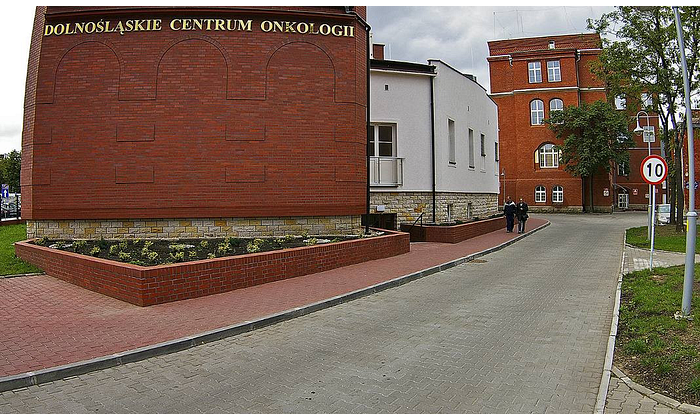New Halcyon™ systems are helping two centers in Poland accommodate large numbers of patients: the Lower Silesian Center of Oncology in Wroclaw and the and Westpomeranian Oncology Center in Szczecin. In both places, the choice of a new linear accelerator (linac) was limited by the size of the bunkers.

“We wanted a state-of-the-art linac, but we needed one that would fit into our small bunker, which had previously housed a Clinac® 600 and—prior to that—a cobalt radiotherapy system,” said Lukasz Trembecki, MD, radiation oncologist at the Lower Silesian Oncology Center. “Another important factor was the built-in structural shielding [of the Halcyon system], which reduced the amount of shielding we needed inside the bunker walls,” he added.

Michal Falco, MD, PhD, head of the Clinical Radiotherapy Department at Westpomeranian Oncology Center, said that, in addition to fitting into a small space, he needed the new linac to handle a high patient volume. His center services an area with over 1.5 million inhabitants. Besides the system’s small footprint, he said, “it’s extremely fast: we can deliver a fraction in less than three minutes.”
Operational Efficiency for High Patient Throughput
The Szczecin center’s Halcyon system was installed first, in January of 2018. That installation took about a week.* The Wroclaw center’s system was installed that same month, in less than two weeks.* It took much longer for the sites to get needed permits from the Polish Atomic Energy Agency, approving clinical use of the system.
In the year since, Dr. Trembecki and his team have treated more than 250 patients. “We have markedly increased our patient volume,” he said, “which is impressive given that our Halcyon system only runs from 8 a.m. to 3 p.m.”
Dr. Falco and his team are running their Halcyon system for 14 hours and treating about a maximum of 94 patients per day. “We started with partial lesions as well as prostate and gynecological tumors,” he said. “As we have become more adept at using the system, we are targeting tumors in the lungs, the head and neck, and the brain. We are also treating some breast cancer, but we are mainly treating cancers in the abdomen and pelvis.”
Dr. Trembecki’s team reports using the system to deliver VMAT or IMRT treatments for cancer of the lung, prostate, and head & neck, as well as brain and bone metastases. “For small volumes, we normally use one to two arcs or three to four IMRT fields,” Dr. Trembecki explained. “In the case of larger volumes, such as prostate cancer with nodal involvement, we increase the number of arcs to four. The efficiency of the machine is unparalleled. We are setting up, imaging, and treating most patients in ten minutes. In the future, we should be able to increase our patient volumes and treat up to six patients in an hour.”
Simpler QA, Imaging, and Treatment Planning
Quality control on the Halcyon system is straightforward, Dr. Trembecki said, pointing out features like the lack of a C-arm and a stable laser system that is covered by a daily, automated “Machine Performance Check” that serve to make QA processes simpler.
Like the Radiation Oncology Centres (ROC) in Toowoomba, Australia, the Wroclaw center team started with MV-CBCT imaging and added kV-CBCT when it became available with Halcyon 2.0. “At the end of September 2018, we upgraded to version 2.0 with kV-CBCT imaging,” Dr. Trembecki said. “We are now using kV-CBCT for volumetric verification and MV-MV for planar verification. Furthermore, Iterative CBCT is helping us to better visualize fiducials, gray scale, and [certain] anatomical structures.”
With respect to treatment planning for the Halcyon system, Dr. Trembecki appreciates the extent to which the process has been automated. “We feel that the automation reduces the likelihood of human error,” he stated.
Dr. Falco noted that a streamlined image guidance process that allows imaging with every fraction helps his team feel comfortable reducing the margins on planning target volumes, especially for the prostate. Targeting accuracy is further enhanced by the speed of treatment, which leaves little time for intrafraction motion.
Patient comfort, however, is perhaps the most important advantage of the Halcyon system, Dr. Falco said. “The machine allows us to give a dose very fast and very accurately, and that’s a comfort to our patients. Almost one-third of our patients are treated on the Halcyon system, which accommodates twice as many patients compared to our other linacs.”
*Installation times vary in different geographic areas; check with your Varian representative.
_______________________________________________________
The information captured herein represents the genuine experience of the attributed individuals and may not necessarily represent the views of Varian or the above referenced institution. Individuals were not compensated for their participation. Radiation treatment may not be appropriate for all cancers. Individual results may vary.